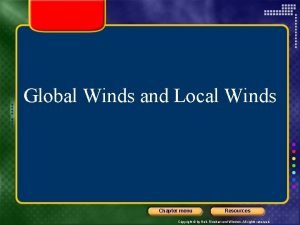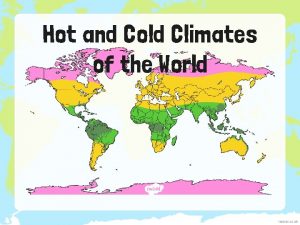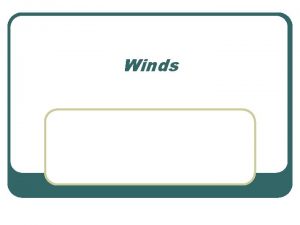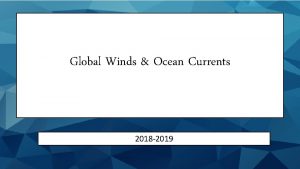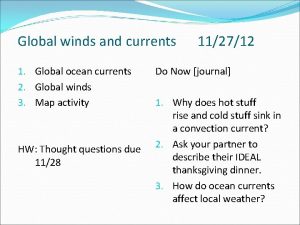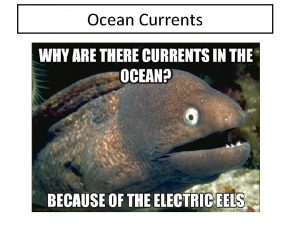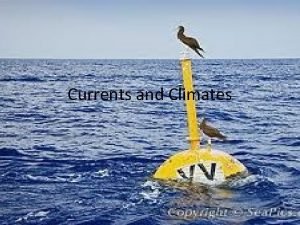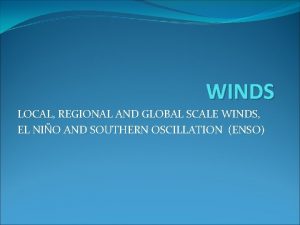Currents Winds and Regional Climates Currents A current














- Slides: 14

Currents, Winds and Regional Climates

Currents �A current is the shifting of water due to either �Changes in heat �Density differences � Where can we see this? Draw an example below:

Changes in heat of water: �Occurs when : �Sea water freezes into ice – the salt remains in the water and doesn’t go into the ice…creating even saltier water! �When water heats up and evaporates, leaving salt in the water behind �What impact does this have on the ocean? � More salt in the water means the water is more dense and it will sink, causing a current to form

Movement of water due to changes in heat

General movement of ocean currents due to HEAT �Cold water at the poles sinks and moves towards the equator �At the equator, the water warms up and rises �Warmer water flows along the surface of the ocean to replace the water moving away from the poles On the diagram of the Earth, draw the movement of water due to heat. Include: • The poles • The Equator • Show the difference between warm and cold water

Density differences in water: �Can also occur when fresh water meets salt water �Eg: When a river empties into the ocean � The Fraser River empties into the Pacific Ocean, carrying fresh water (lower density). How will this impact ocean currents?

Ocean currents due to heat and density changes Gyres are major currents that occur as a result of temperature and density changes around the world. The five main gyres in the world are the: • North Atlantic Gyre • South Atlantic Gyre • North Pacific Gyre • South Indian Gyre • Each gyre is made up of several currents that push cold, nutrientrich water up toward the surface

Wind also impacts ocean currents �Wind causes water to move along the ocean’s surface, by causing the water to mix

STOP! Important pre-knowledge: �To understand wind further, you must understand something called heat capacity: �Specific heat capacity = the measure of a substance’s capacity to store heat � Low specific heat capacity: a substance only needs a small amount of heat energy before it’s temperature starts to rise � High specific heat capacity: a substance will tolerate a large amount of heat energy before it’s temperature starts to rise

Water Specific Heat Capacity The heat capacity of water is among the highest of any substance on Earth, meaning it takes a large change in air temperature to change the temperature of the ocean.

Sea and Land breezes… �Sea breeze: occurs during the day when cool air off the ocean warms up on land rises, eventually sinking back into the ocean as it passes over it. �Land breeze: as the sun sets and the air is less warm over land, heat from the ocean rises

On a global scale…. see NASA footage

Wind and Ocean effects on climate �Currents from warm equatorial waters warm the air above them and they lands they pass near. �Warm air causes evaporation from the ocean, leading to high humidity and lots of precipitation (rain) �Currents from cold waters near the poles cool the air and land around them. �Colder air causes less evaporation, leading to low humidity and less precipitation (snow)

Check Your Understanding �Page 239 – do all questions except for #6
 How does the air move in a sea breeze?
How does the air move in a sea breeze? 6winds
6winds Difference between local winds and global winds
Difference between local winds and global winds Global winds and local winds
Global winds and local winds Earth's rotation makes global winds curve this is called
Earth's rotation makes global winds curve this is called What is deep current
What is deep current Unfenced grasslands in tropical and temperate climates
Unfenced grasslands in tropical and temperate climates Hot and cold world map
Hot and cold world map Line current and phase current
Line current and phase current Phase to phase voltage
Phase to phase voltage N=nc exp(-eg/2kt)
N=nc exp(-eg/2kt) Ac theory 3 lesson 4
Ac theory 3 lesson 4 Drift vs diffusion current
Drift vs diffusion current Drift current and diffusion current
Drift current and diffusion current Balanced wye wye connection
Balanced wye wye connection



